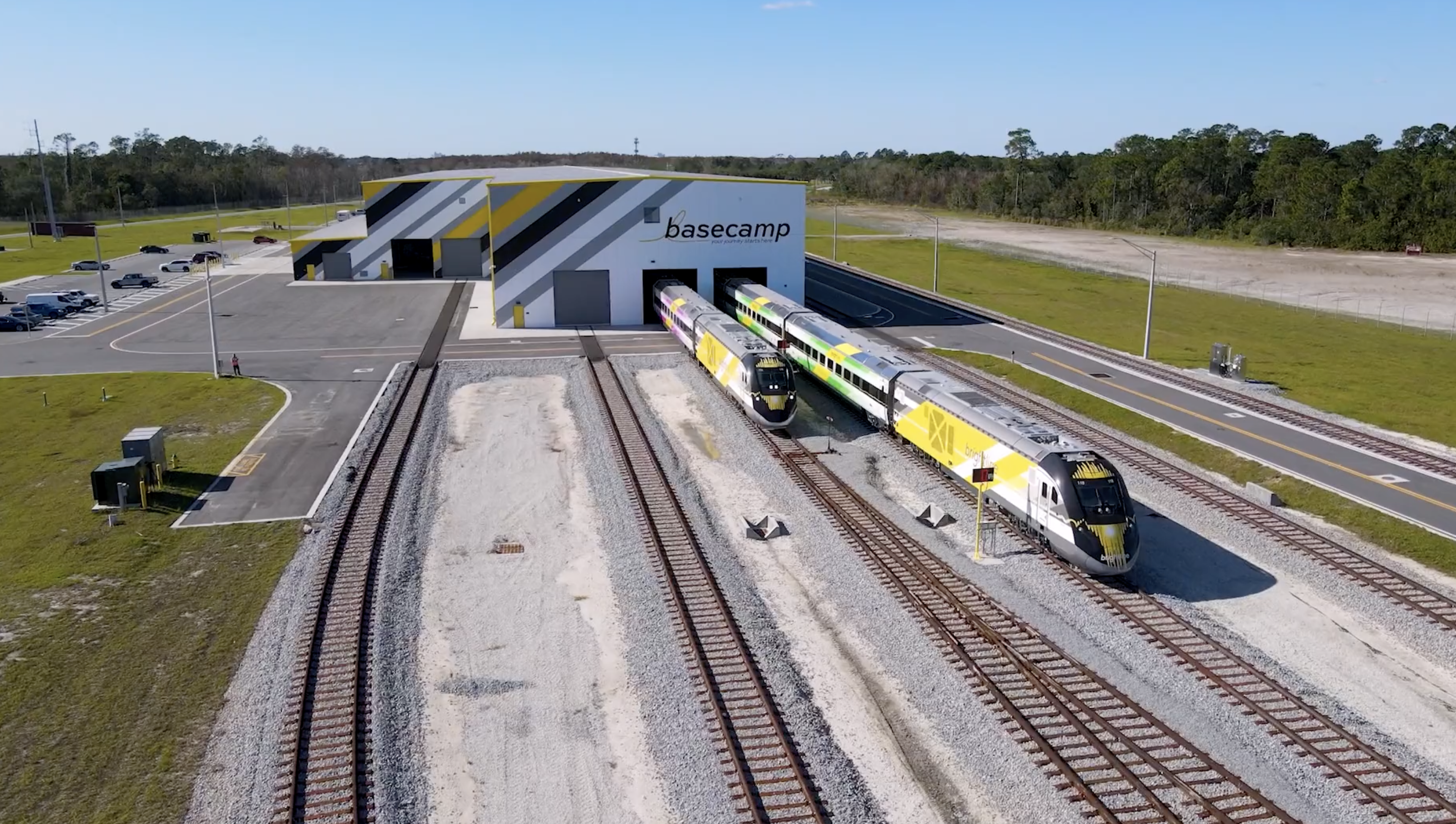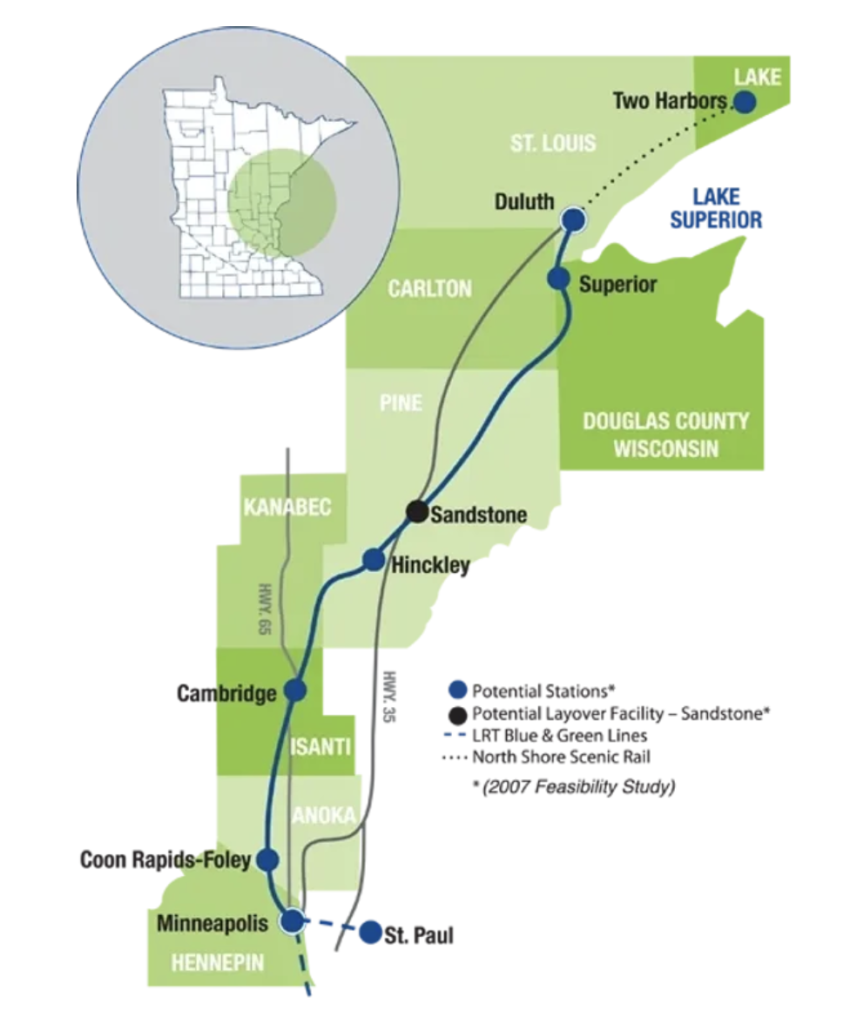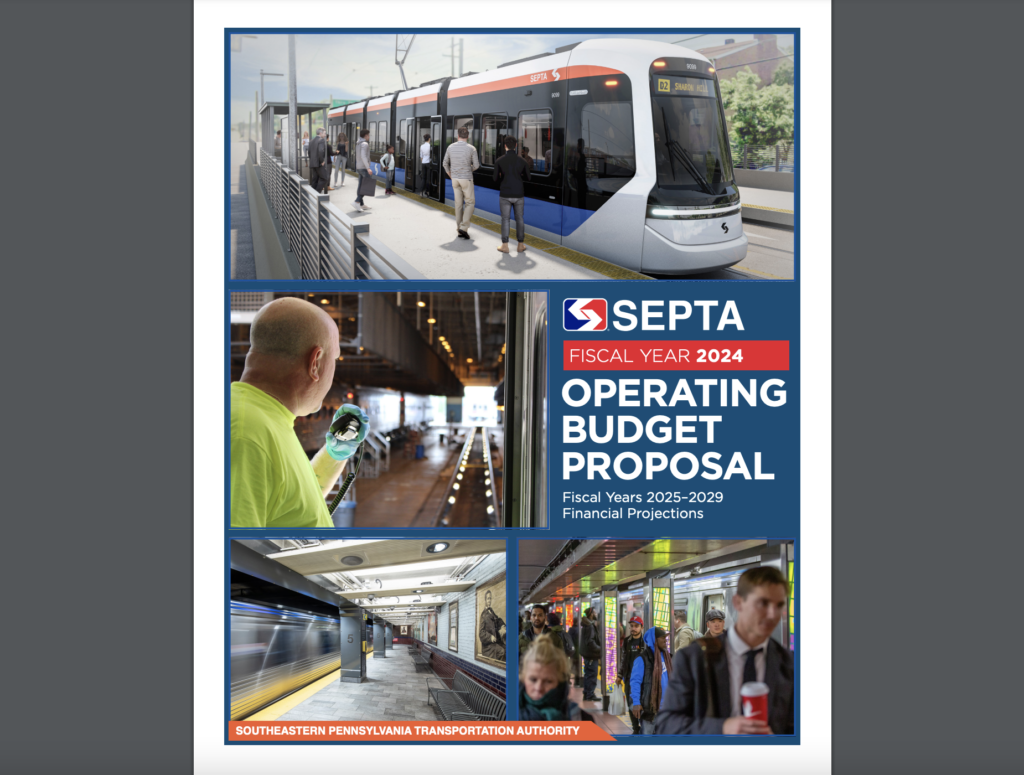
Transit Briefs: Brightline, Northern Lights Express, Tri-Rail, SEPTA
Written by Carolina Worrell, Senior Editor
Brightline, Siemens and Herzog plan to employ 150 highly skilled technical positions at Basecamp, Brightline’s new $100 million state-of-the-art train maintenance facility that can service up to 16 trains at a time. (Screen grab courtesy of Brightline)
Brightline teams with Valencia College to bring highly skilled jobs to Central Florida. Also, Minnesota is closer than ever to funding the proposed Northern Lights Express (NLX); Tri-Rail ridership continues upward trend in first quarter 2023; and the Southeastern Pennsylvania Transportation Authority (SEPTA) releases proposed Fiscal Year 2024 Operating Budget.
Brightline
Brightline announced April 6 that it is teaming up with Valencia College to prepare students for careers in the rail industry and plans to fill 175 new roles in Central Florida, including technical positions within Brightline’s operations and specific to the company’s fleet of trains. Since 2014, Brightline construction and operations has created more than 10,000 jobs, according to the railroad.
According to Brightline, recruitment teams are working with Valencia College to develop talent through a 22-week-long Industrial Automation Technician program, which will help students earn nationally recognized industry credentials. The course, the railroad says, includes five modules: maintenance operation, mechanical, electrical, hydraulics and pneumatics.
As part of this collaboration, Brightline says it is preparing future engineers, conductors, inspectors and technicians for a career with the railroad and its contractors, train manufacturer Siemens Mobility USA and railroad contractor Herzog.
Currently, 10 Valencia graduates have already been hired to work at Brightline, including Davonne Durand, a West Palm Beach native who grew up around Brightline trains. Brightline, Siemens and Herzog plan to employ 150 highly skilled technical positions at Basecamp, Brightline’s new $100 million state-of-the-art train maintenance facility that can service up to 16 trains at a time. Brightline jobs will start at a minimum hourly rate of $20 per hour. Brightline says it intends to work with other regional schools on similar programs in the area to develop future talent.
“Valencia College guided me through this program, every step of the way,” said Durand, a Facility Engineer at Brightline Basecamp and Valencia College graduate. “The technical program at Valencia prepared me for a career at Brightline’s Basecamp with a company that is making history and in a field that will continue to grow.”
“As we ramp up for service to Orlando we need teammates with highly technical skills to work on our trains and our facilities,” said Brightline Chief Mechanical Officer Tom Rutkowski. “Once Orlando service begins, it will remain an ongoing team effort to maintain our 10 trainsets, hundreds of miles of track and our full-service vehicle maintenance facility, Basecamp. We are eager to work with Central Florida colleges to find candidates for these positions.”
“With Brightline coming to Orlando we know that there is going to be a need for technicians, so our career placement teams made contact with Brightline and Siemens to find out exactly what skills they needed,” said Tiffaney Barnes, Senior Director, Accelerated Skills Training Programs, Valencia College. “Our Industrial Automation Technician program is a perfect fit, and we are now actively training students for careers at Brightline’s Basecamp.”
Northern Lights Express
The long-sought passenger rail between Duluth and the Twin Cities in Minnesota still appears “closer than ever to reality” this year, with both the House and Senate versions of a transportation budget including funding for the service, according to a Duluth News Tribune report.
According to the report, advocates of the NLX rail project, who have been pushing for years to restore Twin Cities-Duluth passenger rail travel, still say this year is “the closest the state has come to funding the line.” Estimates, according to the Duluth News Tribune report have placed the price tag of NLX at $450 million—but Minnesota would only have to chip in 20% of the total, as the federal government would pay $4 for every $1 from the state.
According to the Duluth News Tribune report, as “Democratic-Farmer-Labor majority lawmakers prepare their major budget bills, both the Senate and House transportation packages, or omnibus bills, contain funding for NLX. But there’s a key difference between the proposals: The House version calls for $194 million to get the line started, whereas the Senate version calls for $50 million.”
“The amount in the current Senate proposal would fall short of what’s needed to get the matching federal funds to support the full cost of NLX. Meanwhile, the $194 million would unlock nearly $1 billion, far more than the estimated cost of the project. Earlier this year, Senate and House DFLers introduced bills calling for $99 million for the line, though Minnesota tends to pass budget bills as larger packages,” according to the Duluth News Tribune.
NLX Alliance, a coalition of groups along the route, said legislators “want to take advantage of federal passenger rail funding” and called the line “a key link in a Midwestern passenger rail network.”
A Senate DFL spokesman, according to the report, said “there’s a commitment in both chambers to get NLX funded,” and while there’s a discrepancy in funding now, “it’ll get hammered out later on in the session in a conference committee between the House and Senate.”
According to the Duluth News Tribune report, supporters of NLX are enthusiastic this year about the odds for the proposed rail line now that the DFL controls all three branches of state government. For years, according to the report, the proposal “never gained any traction in the divided Legislature, where Republicans opposed restoring rail travel between the Twin Cities and Twin Ports.”
“We’re optimistic,” NLX Alliance spokesperson Jill Brown said in an email, according to the report. “We’ve come close before. This is the year.”
If funding comes, advocates say service would begin in about three years.
According to the Duluth News Tribune report, GOP lawmakers, including those along the route, “question if the level of ridership and length of the trip would justify the expense.” The Minnesota Department of Transportation (MnDOT) estimates a trip on the NLX would take about 2½ hours and could possibly outperform drive times depending on weather and traffic. Transportation officials estimate up to 750,000 people will ride the train in the first year of service.

According to the report, NLX would use 152 miles of existing BNSF Railway track and connect Target Field in downtown Minneapolis to the St. Louis County Depot in Duluth. Stops are planned in Coon Rapids, Cambridge, Hinckley and Superior.
Amtrak last operated a passenger rail route between the Twin Ports and the Twin Cities in the mid-1980s and has agreed to run NLX if it moves forward.
Groups backing the passenger rail line already have a plan for the project which is “shovel-ready,” according to the Duluth News Tribune report. BNSF, according to the report, has said it would “not take an official stance on the project until funding is secured.”
Details on final funding amounts are expected to come after lawmakers return from the legislative spring break. The last day of the session is May 22.
Tri-Rail
The South Florida Regional Transportation Authority (SFRTA) reported April 5 that Tri-Rail ridership has continued its increasing trend in 2023, averaging more than 13,000 weekday and 6,500 weekend passengers in the first three months of the year, an overall 25% increase from the same time last year. Tri-Rail has begun 2023 surpassing 300,000 rides in its first three months, a feat, the agency says, accomplished just four times in 2022.

According to Tri-Rail, the agency reported a 30% increase in January 2023, compared to the same month last year. Similarly, February 2023 had a 27% increase and March 2023 a 20% increase, compared to the same months in 2022. March 2023 is also the first month where Tri-Rail surpassed 350,000 passengers in a month since February 2020, according to the agency.
“Thanks to the commitment of our daily commuters combined with South Florida’s year-round airport travelers, Tri-Rail ridership numbers remain on the upswing,” said Commissioner Raquel Regalado, SFRTA Governing Board Chair. “We have also witnessed many leisure travelers onboard as people take the train to explore new destinations in South Florida.”
A recent survey performed by the agency showed that 50% of passengers ride the train to get to work and 32% use the train to travel for leisure. Forty-six percent of respondents said they traveled to the airport, whether for work or leisure.
Hundreds of students take the train daily to and from school, and weekend ridership has been at above-average levels, the agency said, thanks in great part to recent regional events like Ultra Music Festival, Calle Ocho, Lake Worth Beach Street Painting Festival and Tri-Rail’s Rail Fun Day.
“There have been days where we carried up to 1,000 bikes onboard the trains, so we are working at adjusting our equipment to continue to accommodate the influx of riders,” added David Dech, SFRTA Executive Director. “We give a big thanks to our passengers for counting on us as their best substitute for driving on I-95 and we promise there will be more improvements to come.”
SEPTA
SEPTA on April 5 released a proposed $1.69 billion Operating Budget for Fiscal Year 2024, using the agency’s final installment of federal COVID relief funding that has helped to avoid service cuts and fare increases associated with pandemic-induced revenue losses.

The federal COVID relief funding is forecast to be exhausted in April 2024, and SEPTA says it will face “recurring structural deficits exceeding $240 million starting in Fiscal Year 2025—raising the prospect of service cuts and fare increases as early as next year without additional funding.”
SEPTA’s Operating Budget funds the everyday expenses of running the system, such as labor, energy, fuel, cleaning, and security. The budget, the agency says, has been significantly impacted by inflation, with a proposal for Fiscal Year 2024 that is 4.7% above the budget for current Fiscal Year 2023.
The budget, SEPTA says, proposes continued investments in safety and security; hiring to address historically high vacancy levels; and new technologies to improve the customer experience. Implementation of SEPTA’s Efficiency & Accountability Program has helped to offset cost increases, with savings initiatives reflected throughout the proposal, the agency adds.
Targeted fare enhancements are included in the proposal to continue to boost ridership post-COVID. The proposal, SEPTA says, would make travel more convenient and affordable by providing customers with access to a second free transfer, and by adding 24 inner-ring Regional Rail stations to the network of stations accessible with a weekly and monthly TransPass, including all Zone 1, Airport Line, and Center City stations.
The proposal also features the ongoing expansion of SEPTA Key Advantage, which now has more than 30,000 participants and recently expanded eligibility to all employers, colleges, and universities across the region.
There will be four public hearings about the Operating Budget, with sessions on May 8 at 11 a.m. and 5 p.m., and May 9 at 10 a.m. and 4 p.m. For the first time in four years, SEPTA will offer an in-person option for public participation at the hearings, which will be held at SEPTA Headquarters. Participation will also continue to be offered virtually. The SEPTA Board will consider the proposal at its June meeting. If approved, it will go into effect with the start of Fiscal Year 2024 on July 1.
“We are doing absolutely everything we can to grow revenue through ridership growth and tighten our belts through efficiencies, but those measures alone are not enough,” said SEPTA General Manager and CEO Leslie S. Richards. “This will be the last budget proposal without service cuts and fare increases unless SEPTA receives additional support from our funding partners.”
Next week, SEPTA says it will unveil its proposed Fiscal Year 2024 Capital Budget and 12-Year Program. The proposed Capital Budget will lay out the Authority’s vision for “continuing core infrastructure improvements and advancing projects of significance for the region.”


